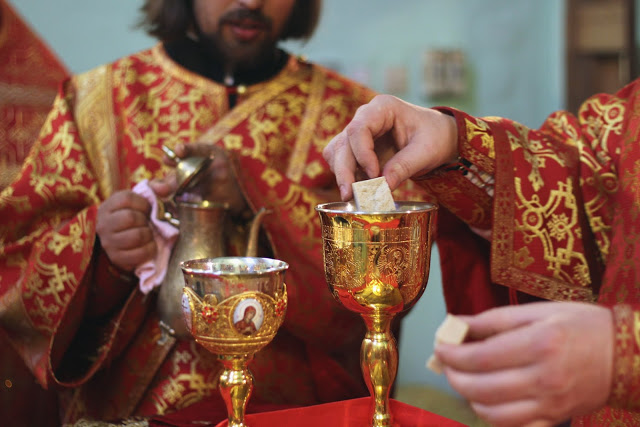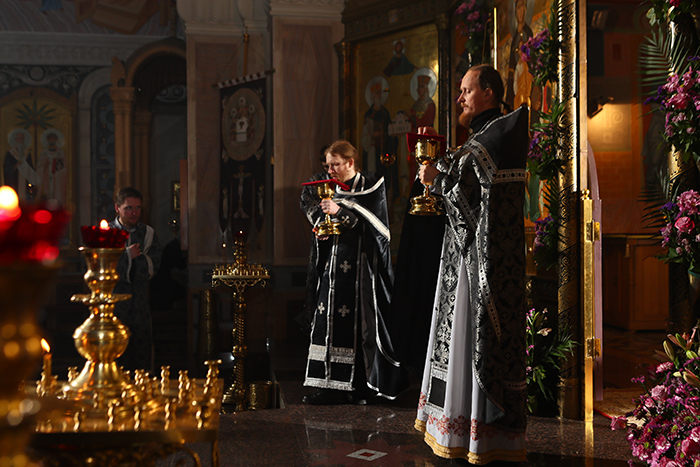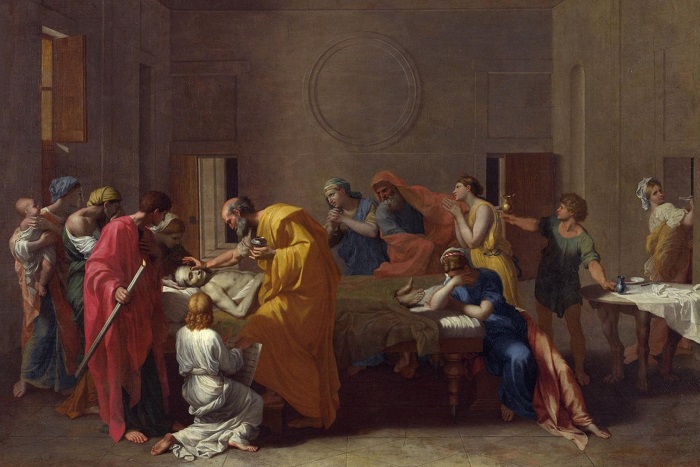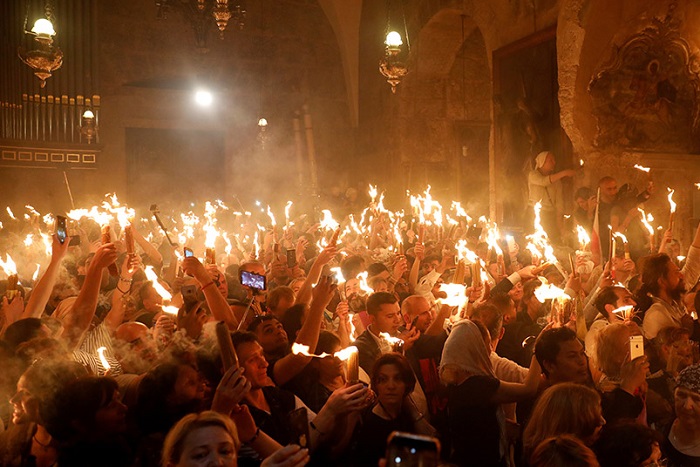
I sometimes cannot help asking myself three liturgical questions whenever I visit churches which serve the Liturgy in the “classic” pattern I learned in seminary — all of those questions quite rhetorical. I would like to share them here in a spirit of calm inquiry in the hope of provoking helpful discussion about things liturgical. My approach might be styled as motivated by a spirit of “liturgical reform” by some, or even “renovation” by the less sympathetic, but my aim is not so much reform or renovation as a return to patristic common sense. That is, at Liturgy I cannot help wondering what St. John Chrysostom would think about what we have done with the Liturgy ascribed to him, and concluding that he would be less than thrilled at some of the changes that have evolved over the years. This does not mean that we should take the liturgical scalpel to the texts as Vatican II has done with the Roman Mass. But it does mean that if certain aspects of our praxis would raise the eyebrows of a Chrysostomus redivivus, perhaps we should revisit that praxis.
Question one: why do the people say “Amen” to prayers that they have not heard? Where the practice obtains of saying the prayers silently, the priest will say (for example) the prayer after the Great Litany silently or quietly enough not to be heard by the congregation, and then raise his voice so that the final bit of the prayer can be heard: “for unto You are due all glory, honour, and worship: to the Father and to the Son and to the Holy Spirit, now and ever unto ages of ages”. The congregation (or perhaps the choir, substituting for the congregation) then answers, “Amen”. The part that can be heard is not a prayer, or even a sentence, but simply a clause. The problem, of course, is that such a practice makes nonsense of the people’s response “Amen”. The word “amen” does not mean “the prayer is over”. As St. Justin Martyr explained long ago, it signifies “so be it” (in his Greek, genoito/ γενοιτο), and represents the people’s participation and assent to what has been said. This congregational assent transforms the utterance from being the private wish and prayer of the celebrant into being the corporate prayer of the gathered church. As Schmemann says (in his book The Eucharist), “With this word the ecclesial assembly concludes and, as it were, seals each prayer uttered by the celebrant, thereby expressing its own organic, responsible and conscious participation in each and every sacred action of the Church”. This presupposes, of course, that the prayer has been uttered and heard. Of course the people know (maybe) what the priest has said silently, but private knowledge is not the point. Liturgical worship is not private knowledge, but public utterance. As it is, the people are sealing not a prayer, but a clause, one with minimal content. The fact that this is not felt as odd reveals how greatly the role of the laity has been devalued and rendered liturgically irrelevant.
And sometimes it is worse than this. In places where the priest serves without a deacon, it is customary for him to intone the Great Litany, and then straightway intone the final clause of the prayer (the so-called exclamation or ekphonesis), and then, after the Amen has been sung, say the prayer quietly during the singing of the First Antiphon. (Presumably this is why that prayer is called in the liturgy books “The Prayer of the First Antiphon”.) This means that the people are saying their Amen not only to a prayer that they have not heard, but to a prayer that has not yet been said. Their “amen” and their role then is not only irrelevant, but nonsensical. I can imagine St. John Chrysostom raising his eyebrows.

The second question is this: why do we sometimes talk to people who aren’t there? I refer of course to catechumens in congregations where catechumens do not exist. Whether or not a congregation has catechumens within it, oftentimes the deacon and priest will assume they are there and talk to them. The deacon begins by addressing them, “Pray to the Lord, you catechumens!” and then goes on to pray for them. He will conclude by talking to them again, bidding them, “Bow your heads unto the Lord, you catechumens!” Then the priest prays a prayer, asking God to look down upon the catechumens “who have bowed their necks before” Him and unite them to His holy Church through baptism. After all this, the deacon again talks to them, ordering them twice to “depart” and again to not remain. But if no catechumens are there, who are priest and deacon talking to and about? Generally speaking, sane people do not talk to people who are not there as if they were.
If a congregation does have catechumens, it is reasonable for them to pray for these catechumens even when they are absent—but not to talk to them. In the case of absent catechumens, the church might reasonably pray for them in the third person, omitting the lines in which catechumens are addressed in the second person (e.g. “Pray to the
Lord, you catechumens!”). And of course one would not tell people to leave who were not present in the first place. As it is, we are talking to catechumens who aren’t there, and then telling them to leave, when we would in fact want them to remain even if they were there. When Chrysostom had his catechumens dismissed, he expected them to actually leave. That is, his words had existential meaning and a corresponding reality in congregational life. He would wonder why we pretend we have catechumens when we don’t, why we tell them to pray and bow their heads to the Lord when they are not there, and why we tell them to leave when we expect them to stay for coffee hour, or at least until the end of the service.
Lord, you catechumens!”). And of course one would not tell people to leave who were not present in the first place. As it is, we are talking to catechumens who aren’t there, and then telling them to leave, when we would in fact want them to remain even if they were there. When Chrysostom had his catechumens dismissed, he expected them to actually leave. That is, his words had existential meaning and a corresponding reality in congregational life. He would wonder why we pretend we have catechumens when we don’t, why we tell them to pray and bow their heads to the Lord when they are not there, and why we tell them to leave when we expect them to stay for coffee hour, or at least until the end of the service.
Question three: why do we pretend things have happened when they haven’t? Here I refer to several things. In some congregations the deacon cries out before the Gospel, “Stand upright!” (or “Let us attend!”; the Greek is orthoi/ ορθοι) and in some places this is taken as the signal to kneel. We tell people to stand up straight, and then don’t bat an eye when they do the opposite. Their piety may be commendable (if a touch uncanonical), but it makes nonsense of the liturgical direction.

It is similar later on when the people are bidden to bow their heads to the Lord (i.e. bow their heads forward so that the priest may extend his hand over them to bless them), and everyone present remains with unbent neck—except, oddly enough, the priest who turns his back on them to bow his head to the Lord. Or, most strangely of all, the diaconal command, “In the fear of God and with faith, draw near!” This is, of course, not a suggestion, but a command to all those listening to come forward to receive Holy Communion. The liturgical text assumes that the people have obeyed and that everyone present drew near, for the next diaconal litany begins, “Stand upright! Having partaken of the divine, holy, most pure, immortal, heavenly, life-creating and awesome mysteries of Christ, let us worthily give thanks unto the Lord”. In some congregations hardly anyone comes forward to receive (I remember being in one packed Greek church of about 500 people, where my wife and I and four other people were the only communicants), but the deacon insists on chanting as if the congregation had partaken of the divine and holy mysteries. In all this we see a gap between what we say and what actually happens. Our liturgical words have been, if not exactly emptied of meaning, then certainly subject to an existential erosion of meaning. We no longer mean exactly what we say. Constantinople’s pastor, I suggest, would not be amused.
What to do? One sometimes hears that no one can do anything to close the gap between words and reality in the Liturgy without the pronouncements of an Ecumenical Council. Such a view of history is defective. As a matter of historical fact, liturgies evolved throughout the centuries through shared local variation, quite apart from the mandates of an Ecumenical Council. Such councils, whether “ecumenical” or “provincial”, only concerned themselves with liturgical details when abuses and problems became widespread enough to merit their attention. Thus the Council of Nicea ruled that deacons should not commune presbyters (canon 18), and that one should not kneel liturgically on Sundays, or during the Paschal season (canon 20). Thus the “Quinisext” Council ruled that the pre-Eucharistic fast should be maintained even on Holy Thursday (canon 29), and that milk and honey should not be offered on the altar (canon 57). In all these rulings the councils were not concerned to police every liturgical development that occurred (which was beyond their power even if they had wanted to), but to simply curb developments they felt were widespread abuses. Liturgy grew and developed because it was alive, and quite apart from conciliar decrees. (For a quick overview see Taft’s The Byzantine Rite: A Short History.) The bishops had the major share of decision-making and control because the bishops then (unlike now) were the local pastors. As such, of course they had liturgical authority over the churches in which they had the weekly burden of pastoral care.
For now, the best we can hope for is to at least start the discussion. It is not an unimportant one. And we should hold the discussion realizing that St. John Chrysostom is watching us with interest. He might not now get a vote in the proceedings, but his approval or disapproval should surely matter to us.
We invoke his name and his authority at the conclusion of every non-Lenten Liturgy, and we will one day have to face him and perhaps explain to him why it is we serve “his Liturgy” the way we do.





I hope you find your answers Father.